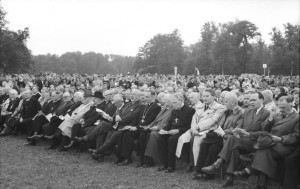Contemporary Church History Quarterly
Volume 19, Number 2 (June 2013)
Review of Wilhelm Damberg, ed., Soziale Strukturen und Semantiken des Religiösen im Wandel (Essen: Klartext, 2011), 224 Pp.
Originally reviewed for H-Net: Humanities and Social Sciences Online (H-German).
By Lauren N. Faulkner, University of Notre Dame
Religious Transformations in the Post-War World
In 2003, an interdisciplinary group of historians, theologians, sociologists, and educators in religious studies met at Bochum University, one of Germany’s pre-eminent research institutions, to commence an ambitious study of religious processes of transformation. In addition to religion, their specific focus was die Moderne, usually translated as “the modern” and, insofar as its definition is concerned, much open to debate in any language. With the support of the Deutsche Forschungsgemeinschaft (DFG), this collection of essays, Soziale Strukturen und Semantiken des Religiösen im Wandel, edited by Wilhelm Damberg (Essen, 2011) is deliberately presented as an interim account [Zwischenbilanz] focused on the German republic. The larger research project is meant to produce several more volumes in the coming years, moving beyond the current volume’s chronological framework (1949-1989) as well as embracing transnational perspectives.
Damberg, a professor of church history at Bochum, edited the volume with the aid of Frank Bösch, Lucian Hölscher (who provides the final essay on secularization), Traugott Jähnichen, Volkhard Krech, and Klaus Tenfelde, who passed away shortly after its publication. Damberg is the author of the very detailed introduction, in which he both sketches the broad contours of the Bochum group’s project and offers useful overviews of the essays and their place within the larger context of the project. In pursing an investigation of the transformation of religion in Germany after the Second World War, several themes run concurrently through the essays: the sociology of religion, including analyses of the processes of secularization, democratization and privatization; the emergence of “new histories” and their attention to religion (as opposed to older histories, particularly of West Germany, which treated religion as a separate, unintegrated chapter); and theological developments, innovations, and controversies, including the impact of Vatican II and the attempts of the Protestant churches to come to terms with the recent German past.
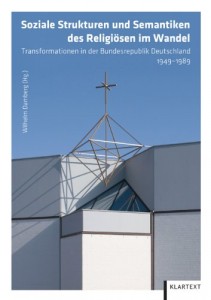 Many of the authors offer inter-denominational (that is, Protestant and Catholic) comparison, with an emphasis on the rise and influence of mass media, and the nature of the discourse about the role of religion and spirituality in the daily lives of individuals, including its participants and changes over time. These reflect the ambitions of the larger Bochum project: to produce a detailed examination of the religious sphere and its gradual change over the years and decades since the last world war, and to evaluate the multiple influences of geography, gender dynamics, political contexts, economic realities, and the fluctuating strengths and weaknesses of ecclesiastical and non-ecclesiastical institutions. Above all, the project highlights the interdependence of the social and the cultural worlds, which are treated as concurrent, overlapping spheres rather than distinct entities. The processes and influences under consideration are situated in a six-point matrix that has a vertical dimension, divided into macro-, meso- and micro-levels, and two broad sociological dimensions, semantics and social structures (a helpful diagram is provided on 23).
Many of the authors offer inter-denominational (that is, Protestant and Catholic) comparison, with an emphasis on the rise and influence of mass media, and the nature of the discourse about the role of religion and spirituality in the daily lives of individuals, including its participants and changes over time. These reflect the ambitions of the larger Bochum project: to produce a detailed examination of the religious sphere and its gradual change over the years and decades since the last world war, and to evaluate the multiple influences of geography, gender dynamics, political contexts, economic realities, and the fluctuating strengths and weaknesses of ecclesiastical and non-ecclesiastical institutions. Above all, the project highlights the interdependence of the social and the cultural worlds, which are treated as concurrent, overlapping spheres rather than distinct entities. The processes and influences under consideration are situated in a six-point matrix that has a vertical dimension, divided into macro-, meso- and micro-levels, and two broad sociological dimensions, semantics and social structures (a helpful diagram is provided on 23).
The essays themselves can be grouped into three distinct categories. In the first, devoted to religious socialization, Dimitrej Owetschkin takes on the changing role of priests, pastors, and the “priestly image.” Markus Hero examines the evolution of alternative religious forms, including non-institutional spiritual movements of the private, popular, and individual natures. Although Owetschkin and Hero are focusing on very different actors – one the lower clergy of institutional churches, the other new and unprecedented spiritual figures who had nothing to do with these churches – both locate the 1960s as an important nexus of the necessary transformative processes. Social engagement and criticism, a growing sense of “world responsibility”, the need for the churches to become more expansive and horizontal, and less vertical (concentrated on hierarchy and authority), the drop in the number of regular church-goers, and the growth of the service industry are a few of the several factors that Owetschkin and Hero cite in their analyses.
The second category deals with changes in the “business” of religion. Andreas Henkelmann and Katharina Kunter’s article examines the breaks with tradition in the fields of charity work and social welfare. Uwe Kaminsky and Henkelmann continue the study of social welfare trends in looking at the evolution of psychological counseling, and the emergence of church-run counselor services in the 1950s as a new kind of charity. Rosel Oehmen-Vieregge investigates the development of women’s synods across (Western) Europe from the 1970s on. Sebastian Tripp’s article confronts the challenge of globalization to the institutional churches, the impact of decolonization on church missions, and changing perceptions of the Third World. Initiatives and pressures external to church leadership play a key role in each article. For Kunter, Kaminsky, and Henkelmann (who co-authored both pieces on welfare and charity), church-run organizations and clergy remained intrinsic to these kinds of operations, but demands for professionalization and the availability of new kinds of education, particularly in the discipline of psychology, meant increased involvement of lay professionals, including women. Oehmen-Vieregge underscores the role that women played in becoming more active in church life via the formation of various women’s synods from the 1970s to the first decade of the twenty-first century, and Tripp follows with an analysis of the new initiatives and kinds of legitimacy that emerged among Third-World groups and missions after the disintegration of the colonial world. None of these articles goes so far as to suggest that traditional church leadership was overtly challenged, but all point to various new agents who had little to no relationship with church leaders, who gained mounting influence in operations that for decades had been under the prerogative of the churches.
The final category considers religion in the age of mass media and “the public” [die Öffentlichkeit]. Sven-Daniel Gettys discusses changes in church policy regarding journalism and information sharing. Thomas Mittmann examines the ways in which the traditional churches attempted to maintain their social influence while simultaneously acknowledging the need for increased democratization through the use of popular events and the introduction of new liturgies and worship services. Nicolai Hannig studies the role of the media in shaping religious beliefs in an age of rapidly-developing media technology. Benjamin Städter’s article a good complement to Hannig’s, focusing on the production of visual images of Vatican II and their proliferation and impact. Whereas Gettys and Mittman are interested in exploring the self-perception of the institutional churches by looking at hierarchical attitudes towards different forms of media, journalism, and church congresses, Hannig and Städter focus on the types of media that have tried to make the churches and religion more accessible, via documentaries, opinion polls, and the magazine Stern’s public survey about religion in 1965, and via the publication and dispersal of photographs of popes, the church hierarchy, and the opening of Vatican II.
Lucian Hölscher’s article serves as a conclusion to the volume, examining various understandings of the slippery term “secularization” during the long 1960s. Hölscher’s investigation of the idea of secularization provides a terminological reflection on a word that appears in most of the essays in the volume, introducing the reader to a brief history of the term and suggesting that, if we accept that “secularization” is one of the twentieth century’s central concepts, more study must be conducted on the relationship between state and society in view of the religious sphere (and not merely on the social aspects of religion and the churches).
Readers should be aware of what the book is not: it is not a series of essays about people themselves who effected change. This volume deals with concepts – the transformation of semantics and structures, as the title indicates – rather than individuals. The authors are focused on processes and shifts over time in beliefs, attitudes, and modes of expression about religion and faith. There are very few named individuals, and none at all who serve as the explicit subject or focus of a study. The result is a volume that is oddly bereft of people, despite its interest in the ways people individually (the micro-level, as stipulated in the introduction) and collectively (the meso- and macro-levels) experience and communicate about religion.
The book’s self-proclaimed aim, to study religious transformation in the modern era, means that its subject is large, ambitious, and not uncontroversial. And admittedly, there are some gaps. Damberg concedes in the introduction that the absence of East Germany in this study is notable, though he points to separate studies that are in the works. Yet the volume’s attention to comparison, and the willingness of some of the essays to discuss the post-1990 period, leaves the reader thirsting for an idea of what was going on with East Germans and how they contributed to the post-1990 happenings. With few exceptions – Oehmen-Vieregge mentions the participation of Muslim women in some women’s gatherings; Hero discusses non-traditional spiritual figures, including gurus, shamans, and astrologers – the “religious sphere” is confined to and defined by the Christian religions, leaving one impatient for the volumes (which are forthcoming) dealing with non-Christian ones, particularly the impact of Muslims and Jews in Germany in the last third of the twentieth century.
One may also criticize the book for being jargon-heavy, though the authors do provide definitions and explanations, sometimes quite detailed, especially if the word is controversial, of most of the terms in use (Eventisierung, featured prominently in Mittmann’s article, may be the only concept that has no ready English equivalent). In fact, this exercise in probing definitions is one of the book’s true strengths, since it invites the reader to rethink and challenge longstanding assumptions about different aspects of religious change in the twentieth century. In selecting “transformation” as the leitmotif of the book, normative concepts are destabilized, poked and prodded, and interrogated in innovative and enlightening ways. While the definition of words like modernization and secularization remain variable, their meaning and impact on events and people, from psychologists and journalists to parish priests and pastors, is made clearer. Other terms, including liberalization, democratization, and pluralization, are given added coherence as individual articles demonstrate how they emerged to become important vehicles of change over time.
The book is also a successful example of distinctive approaches to the same subject: it is a solid showcase for effective interdisciplinary research and writing. The various methodologies emphasize the different research fields and specialties of the authors, who hold degrees in sociology, history, theology, philosophy, economics, and political philosophy. A list of publications of these authors is included at the back; perhaps in future volumes, a list of short author biographies will also be included (biographies of authors for this book are found easily online, on the DFG-Forschergruppe website dedicated to the Bochum Project). Because of the different questions, agendas, and research tools on display in these articles, they yield a multi-faceted, detailed, broad-reaching book that stays true to its core mission: underscoring the displacement, alteration, and relocation of church infrastructure in West Germany between 1949 and 1989, and the instabilities in and changes to religious meaning and interpretation. Moreover, the authors do not attempt to offer the final word on any of the subjects under consideration; this is the opening of a discussion rather than its conclusion. If this book sets the standard for the Bochum Project’s coming volumes, which the editor insists will expand beyond the borders of West Germany and Europe, and beyond the four-decade timeframe featured here, then a significant new series is in the making, and anyone with an interest in the relationship between society and religion needs to take notice.
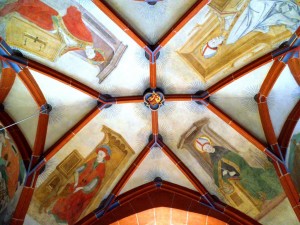

 The record of the German Evangelical Churches, including the Confessing Church of Karl Barth and Dietrich Bonhoeffer, in failing to mobilize opposition to the Nazis’ violent attacks on the Jews is a shameful one. It has been excellently researched in the recent book by Robert Ericksen, Complicity in the Holocaust: Churches and Universities in Nazi Germany. In the post-1945 period, when the horrifying facts of the Holocaust were revealed, the Church was overwhelmed with a deep feeling of guilty shame. The subject was to be avoided. It took many years before the details emerged of one of the more significant, if belated, efforts in the Protestant ranks, namely the establishment in 1938 of an office to assist the persecuted Protestant victims of Nazi oppression. Hartmut Ludwig’s contribution in retelling the story of the “Büro Grüber” is therefore much to be welcomed.
The record of the German Evangelical Churches, including the Confessing Church of Karl Barth and Dietrich Bonhoeffer, in failing to mobilize opposition to the Nazis’ violent attacks on the Jews is a shameful one. It has been excellently researched in the recent book by Robert Ericksen, Complicity in the Holocaust: Churches and Universities in Nazi Germany. In the post-1945 period, when the horrifying facts of the Holocaust were revealed, the Church was overwhelmed with a deep feeling of guilty shame. The subject was to be avoided. It took many years before the details emerged of one of the more significant, if belated, efforts in the Protestant ranks, namely the establishment in 1938 of an office to assist the persecuted Protestant victims of Nazi oppression. Hartmut Ludwig’s contribution in retelling the story of the “Büro Grüber” is therefore much to be welcomed.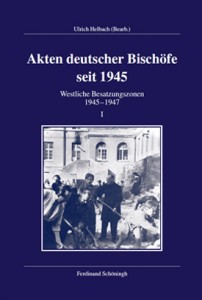 The research behind these editions is tremendous. These three tomes collectively occupy approximately 2400 pages and bring together nearly 725 documents from more than fifty archives, including more than 40 church archives in Germany, German state archives, private papers and two archives from the United States. Before making their final selections, the archivists and research teams assisting them had to wade through thousands of folders of documents and pre-select more than two thousand documents for possible inclusion. The documents themselves include correspondence and addresses not only in German but also in English, French and Latin, as the bishops were in regular correspondence with occupation officials from the Western Allies and the Vatican. Fortunately, the two editors, Dr. Ulrich Helbach, the director of the archive for the archdiocese of Cologne, and Dr. Annette Mertens of the Kommission für Zeitgeschichte, ensured that adept translations into German were provided for the foreign documents.
The research behind these editions is tremendous. These three tomes collectively occupy approximately 2400 pages and bring together nearly 725 documents from more than fifty archives, including more than 40 church archives in Germany, German state archives, private papers and two archives from the United States. Before making their final selections, the archivists and research teams assisting them had to wade through thousands of folders of documents and pre-select more than two thousand documents for possible inclusion. The documents themselves include correspondence and addresses not only in German but also in English, French and Latin, as the bishops were in regular correspondence with occupation officials from the Western Allies and the Vatican. Fortunately, the two editors, Dr. Ulrich Helbach, the director of the archive for the archdiocese of Cologne, and Dr. Annette Mertens of the Kommission für Zeitgeschichte, ensured that adept translations into German were provided for the foreign documents.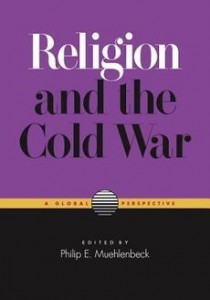 Three essays from this collection that focus on the Catholic and Protestant churches in Europe and America will be of particular interest to CCHQ readers. In his essay, “The Western Allies, German Churches, and the Emerging Cold War in Germany, 1948-1952,” JonDavid Wyneken maintains that the political leaders in the US, Britain, the Soviet Union, and in East and West Germany paid close attention to the stance of German church leaders and at times shaped their policies with the churches in mind. At the end of WWII the German churches believed that they deserved a prominent role in postwar reconstruction and promoted themselves to the Allies as offering a faith-based alternative to the appeals of atheistic Communism. Although the Allies, especially the Americans, found this appealing, they refused to grant the churches the comprehensive role they desired and imposed harsh occupation and denazification programs in their zones of occupation. Church leaders voiced strong opposition to what they called “victors’ justice” and bemoaned that the Western Allies were just making Communism more appealing to a desperate and disgruntled population.
Three essays from this collection that focus on the Catholic and Protestant churches in Europe and America will be of particular interest to CCHQ readers. In his essay, “The Western Allies, German Churches, and the Emerging Cold War in Germany, 1948-1952,” JonDavid Wyneken maintains that the political leaders in the US, Britain, the Soviet Union, and in East and West Germany paid close attention to the stance of German church leaders and at times shaped their policies with the churches in mind. At the end of WWII the German churches believed that they deserved a prominent role in postwar reconstruction and promoted themselves to the Allies as offering a faith-based alternative to the appeals of atheistic Communism. Although the Allies, especially the Americans, found this appealing, they refused to grant the churches the comprehensive role they desired and imposed harsh occupation and denazification programs in their zones of occupation. Church leaders voiced strong opposition to what they called “victors’ justice” and bemoaned that the Western Allies were just making Communism more appealing to a desperate and disgruntled population. Many of the authors offer inter-denominational (that is, Protestant and Catholic) comparison, with an emphasis on the rise and influence of mass media, and the nature of the discourse about the role of religion and spirituality in the daily lives of individuals, including its participants and changes over time. These reflect the ambitions of the larger Bochum project: to produce a detailed examination of the religious sphere and its gradual change over the years and decades since the last world war, and to evaluate the multiple influences of geography, gender dynamics, political contexts, economic realities, and the fluctuating strengths and weaknesses of ecclesiastical and non-ecclesiastical institutions. Above all, the project highlights the interdependence of the social and the cultural worlds, which are treated as concurrent, overlapping spheres rather than distinct entities. The processes and influences under consideration are situated in a six-point matrix that has a vertical dimension, divided into macro-, meso- and micro-levels, and two broad sociological dimensions, semantics and social structures (a helpful diagram is provided on 23).
Many of the authors offer inter-denominational (that is, Protestant and Catholic) comparison, with an emphasis on the rise and influence of mass media, and the nature of the discourse about the role of religion and spirituality in the daily lives of individuals, including its participants and changes over time. These reflect the ambitions of the larger Bochum project: to produce a detailed examination of the religious sphere and its gradual change over the years and decades since the last world war, and to evaluate the multiple influences of geography, gender dynamics, political contexts, economic realities, and the fluctuating strengths and weaknesses of ecclesiastical and non-ecclesiastical institutions. Above all, the project highlights the interdependence of the social and the cultural worlds, which are treated as concurrent, overlapping spheres rather than distinct entities. The processes and influences under consideration are situated in a six-point matrix that has a vertical dimension, divided into macro-, meso- and micro-levels, and two broad sociological dimensions, semantics and social structures (a helpful diagram is provided on 23).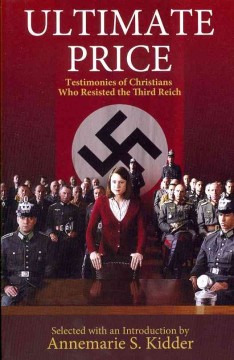 This short selection of texts written by seven notable Germans who resisted the Nazi onslaught against their Christian faith will be a helpful introduction for beginners in this field. While the testimonies of Dietrich Bonhoeffer have been known in English translation for many years, it is good to have these brief and excellently translated extracts from the writings of lesser known figures, such as Sophie Scholl, the Munich student executed for her protests against Nazi totalitarianism, or of Jochen Klepper, the well-known novelist, who committed suicide with his Jewish wife in 1942. On the Catholic side, the Jesuit Father Alfred Delp was also executed for his involvement with the July 1944 plot to overthrow Hitler. His prison letters are, like Bonhoeffer’s, an inspiring witness to his enduring faith. Less known to English-speaking readers will be the testimony of Franz Jägerstätter, the Austrian farmer, executed for his refusal to serve in Hitler’s army, or the courageous stand of the Berlin Cathedral Provost, Bernhard Lichtenberg, who prayed publicly for the persecuted Jews and for the prisoners in concentration camps, for which he was arrested and sent to prison. The only survivor, the Jesuit Father Rupert Mayer, was already arrested in 1937 for his provocative sermons critical of the regime. His refusal to be silenced led to his being imprisoned again in 1938, and then to being placed under house arrest in a distant monastery in 1940. The common theme of all these witnesses was their determination to protest against the injustices of the Nazi regime, even though their motives for doing so varied widely. They were all well aware of their isolation in adopting such views, but were resolved to defend the integrity of their Christian beliefs. Their readiness to challenge the majority’s obeisance, gullibility or fearfulness is what makes these testimonies so compelling. This little book will undoubtedly help to uphold their memory among a wider public, in the hope that their sacrifices will resonate far beyond their own times or their original homeland.
This short selection of texts written by seven notable Germans who resisted the Nazi onslaught against their Christian faith will be a helpful introduction for beginners in this field. While the testimonies of Dietrich Bonhoeffer have been known in English translation for many years, it is good to have these brief and excellently translated extracts from the writings of lesser known figures, such as Sophie Scholl, the Munich student executed for her protests against Nazi totalitarianism, or of Jochen Klepper, the well-known novelist, who committed suicide with his Jewish wife in 1942. On the Catholic side, the Jesuit Father Alfred Delp was also executed for his involvement with the July 1944 plot to overthrow Hitler. His prison letters are, like Bonhoeffer’s, an inspiring witness to his enduring faith. Less known to English-speaking readers will be the testimony of Franz Jägerstätter, the Austrian farmer, executed for his refusal to serve in Hitler’s army, or the courageous stand of the Berlin Cathedral Provost, Bernhard Lichtenberg, who prayed publicly for the persecuted Jews and for the prisoners in concentration camps, for which he was arrested and sent to prison. The only survivor, the Jesuit Father Rupert Mayer, was already arrested in 1937 for his provocative sermons critical of the regime. His refusal to be silenced led to his being imprisoned again in 1938, and then to being placed under house arrest in a distant monastery in 1940. The common theme of all these witnesses was their determination to protest against the injustices of the Nazi regime, even though their motives for doing so varied widely. They were all well aware of their isolation in adopting such views, but were resolved to defend the integrity of their Christian beliefs. Their readiness to challenge the majority’s obeisance, gullibility or fearfulness is what makes these testimonies so compelling. This little book will undoubtedly help to uphold their memory among a wider public, in the hope that their sacrifices will resonate far beyond their own times or their original homeland.